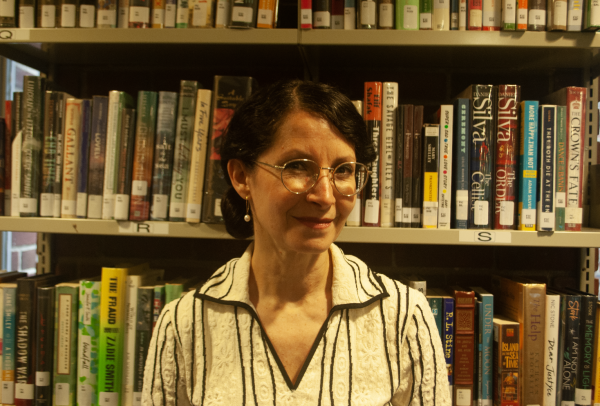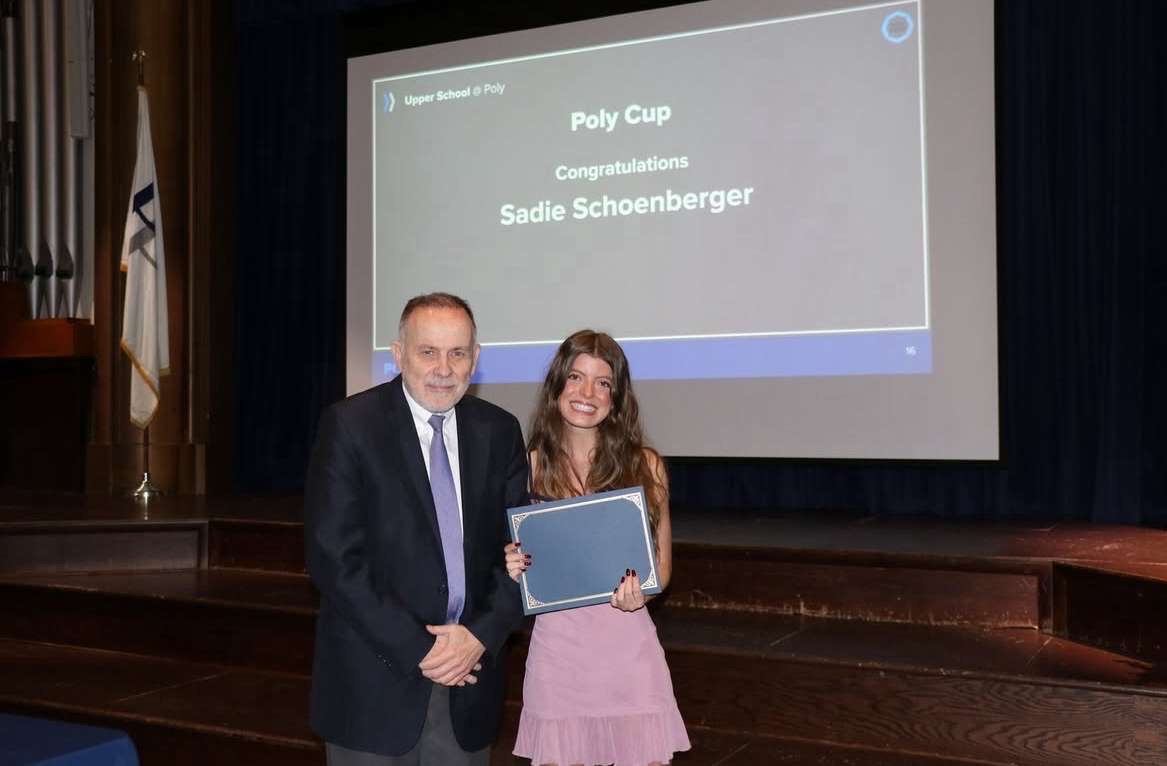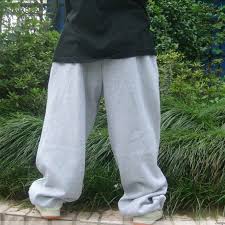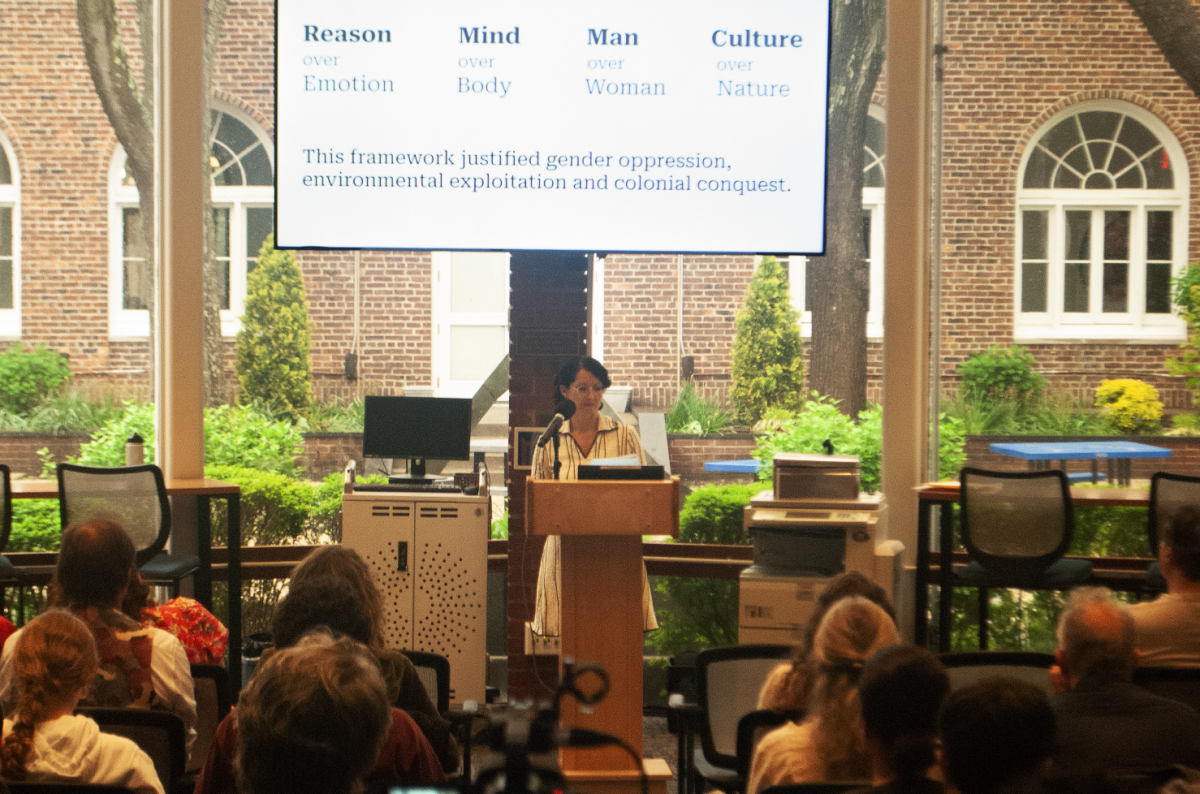On Wednesday, May 14, World Language Faculty Member and English Department Member Maité Iracheta delivered her second Kastendiek Lecture titled “Ecofeminism in the Post human Era.” Iracheta’s lecture developed her own theory of technology’s evolution in conversation with Poly Prep students. Iracheta highlighted the future of education and individual identity, introducing the idea of post-human cyborgs.
Iracheta discussed the evolution of theory in relation to the human mind and body, as well as the positive and negative effects of technology. She used the theories of current-day philosophers to modernize and frame a futuristic theory of the human in relation to technology.
“The Kastendieck Lecture series is named after a former head of the English Department and educator at Poly for 50 years, Dr. Miles Kastendieck…The lecture series provides faculty members an opportunity to dedicate time and deepen their studies of a particular topic within their discipline,” according to the Poly Prep Website.
Iracheta’s lecture was previewed by Dana Catherine, “a friend and former colleague” of Iracheta, as Catherine mentioned in her speech. Catherine continued by contextualizing “[Iracheta’s] foremother, literary godmother, muse and proto-feminist Sor Juana Inés de la Cruz” in relation to Iracheta herself. Catherine explained Sor Juana “defended women’s right to education in the 17th-century Spanish world that defined learning as masculine, and considered ‘mystical knowledge’, or hysteria, as feminine” and considered Iracheta “Sor Juana’s true literary descendant, a polymath in a perhaps more open but equally difficult world.”
Iracheta began her lecture by introducing Colombian artist Doris Salcedo and her 2007 installation project Shibboleth. This exhibition featured four photos illustrating a crack from different angles, and was displayed at the Tate Modern Art Gallery in London, England. “The term ‘shibboleth’ refers to a word, phrase or custom that can be used to test whether or not an individual belongs to a particular group or region… the crack in the floor in the Shibboleth photographs and installation could be seen as a symbol of the damage caused by cultural and geographical exclusion,” according to the Tate Modern Website.
Iracheta then split her lecture into four parts: “From Humanism to Technopharma Capitalism,” “Feminist Interventions: Composting the Human as Cyborg,” “Biopolitics vs. Necropolitics in the Anthropocene,” and “The Ecofeminist Posthuman Convergence.”
In Iracheta’s first part, she briefly recognized philosophers and their ideas in relation to early humanism theories. René Descartes was a 17th-century philosopher who developed the theory of Cartesian Dualism, a proposition that “reason and logic were considered the pillars of the modern era,” said Iracheta. She continued, analyzing, “it had sounded great at the time, if it had not been at the expense of the colonized, marginalized and the environment.” Although there is the argument that Descartes’ theory “laid the groundwork for modern humanism… its promises of liberty, equality and fraternity were bound to a subject that was implicitly white, male, property owning and European.”
Iracheta also highlighted the theory of Paul B. Preciado. He “claims that our contemporary societies are gigantic sexopolitical laboratories where the genders are produced…postwar white men and women are biotechnological beings belonging to the sexopolitical regime whose goal is the production, reproduction, and colonial expansion of heterosexual human life on the planet.” Preciado coined the term ‘pharmacopornographic power’, which references pharmaceuticals — both illegal and legal, and how our health and sexuality are controlled through the regulation of bodies. In 2024, “citizens in the United States spent a record of $98 million out-of-pocket on prescription drugs, a 25 percent increase over five years,” said Iracheta.
In her next two sections, Iracheta claimed that “we are stamped with different degrees of mortality, different ways of access to humanity.” She considers the four waves of feminism: “The first wave was in the 60’s and 70’s and included educated, white women fighting for their rights. The second wave opened up the door to other ethnicities who were also educated, but still, it was not completely exclusive. The third wave included all ages and all ethnicities, and now in the fourth wave, we are considering all the living beings. Not only humans, but also the non-humans.” Iracheta also clarified that men “have always been part of the equation in these feminist movements…they are an essential part of the equation.”
“The current human, the post-human, is no longer a stable identity, but a nod in a web of relations constantly co-constituted by technologies, environments and other life forms.” Iracheta spoke of accepting fluidity in relation to technology and of being able to reimagine cultural binaries. Donna Haraway is another philosopher who introduced the cyborg as “a figure who transcends traditional boundaries, opening a model for post-human subjects that embrace imperfection, hybridity and transgression. The cyborg is not only a hybrid of biology and technology, but also of gender, race and class.” At the same time, Iracheta quoted Harraway: “Our machines are disturbingly lively, and we ourselves are frighteningly inert.”
Rosi Braidotti is a philosopher who believes in dismantling the anthropocentric worldview. Anthropocentrism is the theory that humans are at the center of priority and consideration. Despite the nuance in pinpointing exactly when this theory began, “we can agree that we want to step out of that anthropocene era… and embrace post-human ethics that are rooted in embodiment and vulnerability.” Braidotti expanded on Harraway’s idea of fluidity, offering a perspective on transfeminism. Iracheta explained this concept “pushes back against the rigid structure of gender that has been imposed through patriarchy and colonialism.”
Ágnes Heller, a Hungarian philosopher, believes that in modern society, “the body represents two opposing things: one, the body is legally recognized, and two, prejudices oppress that same body…then there is a third representation in hyper-consumerist societies: the body as a valuable asset. This is related to bio-political power, which bases the body on economic profitability.”
Iracheta also stressed “placenta politics” in her lecture, a concept developed by Italian philosopher Roberto Esposito. Iracheta then followed up in an interview that there are three options Espoito considers regarding contact regulation. There are the two extremes: xenophobia, closing border access and believing in one thing and further rejecting humans that represent another thing — as a result of technology. And then there’s the opposite: opening borders. Then, Iracheta summarized Esposito’s third concept: “Esposito believes the best choice is the placenta. He uses the placenta as a metaphor that when one is developing a baby in their body, they have had the ‘extra help’ from a friend, a lover, a partner. That seed is considered foreign. But it helps bring to life something in the placenta,” she continued in an interview. Esposito calls the concept the ‘immunization’ of the female and the ‘contamination’ of the other, that does not necessarily have a bad connotation. Iracheta continued, emphasizing that “the result is the synthesis of both, which is the best possible outcome that a group or society could have.”

Iracheta’s fourth part focused on Western influence in relation to eco, indigenous, and LGBTQ+ feminists and theorists as pioneers of the anti-anthropocentric practices. The term “ecofeminist” is derived from French feminist Françoise de Jong in 1974. “Colonist practices have led to the appropriation of the land by the terra nullius, a Latin phrase meaning ‘nobody’s land’ or ‘empty land.’ This concept is used to justify the occupation and colonization of land, particularly when Indigenous populations are present by claiming that they don’t have a formal or established legal state to claim sovereignty,” she mentioned in an interview. Iracheta recognized that examples of this oppression have been present not just in Europe, but Indigenous perspectives of inequality are rooted in U.S. history as well.
Iracheta closed her lecture with several quotes by Virginia Woolf: “The future is dark, which is the best thing the future can be” and “as a woman, I have no country.” Influenced by the latter one, Iracheta constructed her own, more precise version in the post-human, ecofeminist context: “As living beings, we have no planet unless social contracts are written from scratch and they can catch up to the global, post-human present needs.”


























